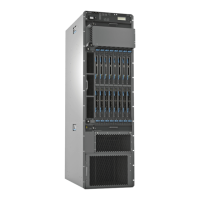Installing a PTX5000 PDU DC Power Cable
To install a DC power cable:
1. Make sure that the voltage across the DC power source cable leads is 0 V and that
there is no chance that the cables might become active. Verify that the –48 V 120 A
LEDs on the PDU faceplate are off.
2. Switch the circuit breaker for the input power tray on the PDU faceplate to the off
position (O).
3. Route the positive (+) DC source power cable lug through the left cable restraint.
4. Secure the positive (+) DC source power cable lug to the RTN (return) terminal, located
on the left, with a nut.
Use a 7/16-in. (11 mm) nut driver to tighten the nut.
5. Route the negative (–) DC source power cable lug through the right cable restraint.
6. Attach the negative (–) DC source power cable lug to the –48V (input) terminal,
located on the right.
Use a 7/16-in. (11 mm) nut driver to tighten the nut.
CAUTION: You must use an appropriate torque-controlled tool to tighten
the nuts. Applying excessivetorquedamages the terminal studs and power
supply. The maximum torque that may be applied to this nut is 99 lb-in.
(11 Nm).
CAUTION: You must ensure that power connections maintain the proper
polarity. The power source cables might be labeled (+) and (–) to indicate
their polarity. There is no standard color coding for DC power cables. The
color coding used by the external DC power source at your site determines
the color coding for the leads on the power cables that attach to the
terminal studs on each power supply.
CAUTION: All inputs on the DC PDU in slot PDU0 must be powered by
dedicated power feeds derived from feed A, and all inputs on the DC PDU
in slot PDU1 must be powered by dedicated power feedsderivedfrom feed
B. This configuration provides the commonly deployed A/B feed
redundancy for the system.
Copyright © 2012, Juniper Networks, Inc.200
PTX5000 Packet Transport Switch Hardware Guide

